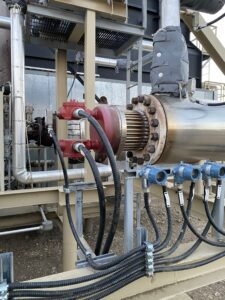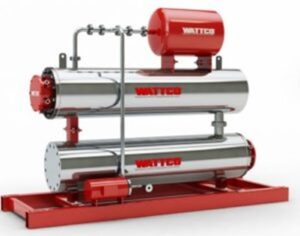Natural Gas Heaters – Applications and Considerations
Last updated on May 17th, 2025 at 02:54 am
Ranking high amongst alternative energy sources, Natural gas is the cleanest burning hydrocarbon. It is transported in its gaseous state through pipelines to far-flung communities as a fuel source for heating or cooking. Due to its versatility, Natural Gas is also compressed into a liquefied gas and shipped vast distances through LNG transporters.
Discovered deep beneath the earth’s surface in geographical formations. Natural Gas is primarily methane (CH4) with water vapor and carbon dioxide traces. Natural gas reserves will last us 230 years in a recoverable state with enormous reserves and constant demand.
Natural Gas preheater is extracted utilizing the current technology available for exploration and production of hydrocarbons. As a source of energy, natural gas is so versatile that a gas-fired power plant uses less time to start up than a coal or furnace oil-fired power plant.
The availability of liquified natural gas around the globe means that it is a gap filler source of energy. Where short-term supply disruptions can result in energy shortages, optimization of LNG becomes crucial. Post the Fukushima disaster, Japan relied on the LNG-powered power plants to replace the lost capacity of nuclear power plants.
HEATING CONCEPTS
Energy Efficiency
Energy efficiency is the ratio of the energy contained in the fuel converting into heat. Part of the energy stored in the fuel is wasted in heat or lost in incomplete combustion, cold startup, and flue gas, taking some of the heat content of the fuel.
Seasonal Efficiency and Annual Fuel Utilization Efficiency (AFUE)
This efficiency considers the cold start and inability of the heating system to reach a steady state. It will not run long enough, especially in the milder weather at the beginning and end of the heating session. Annual fuel utilization efficiency is a seasonal efficiency metric.
The capacity of a particular heating system is measured in kilowatts or kW, Megajoules per hour or MJ/h., British thermal units per hour (Btu/h). Consumption of propane is measured in Liters or L, while natural gas consumption is measured in cubic meters or cubic feet.
Steady-state Efficiency
Steady-state efficiency is the opposite of seasonal efficiency. It is measured when the system has reached its steady-state after running long enough, deducting the cold start. Thus, achieving the optimum operating temperature. It is difficult to achieve a steady state of efficiency due to changes in operating parameters, usually required for occupancy and comfortability.
Natural Gas and inline preheaters for gas turbine generators
 Natural gas preheaters serve a vital purpose in the industry, they use electric immersion heaters to raise the temperature of the natural gas (fuel gas ensuring the correct chemical reaction. Optimizing and yielding maximum efficiency. The most common natural gas preheaters are inline heaters with electric immersion heaters, which transfer the heat to natural gas with accuracy and control to reach the desired temperature.
Natural gas preheaters serve a vital purpose in the industry, they use electric immersion heaters to raise the temperature of the natural gas (fuel gas ensuring the correct chemical reaction. Optimizing and yielding maximum efficiency. The most common natural gas preheaters are inline heaters with electric immersion heaters, which transfer the heat to natural gas with accuracy and control to reach the desired temperature.
Fuel gas pretreatment is optimized for condensation removal and preheating. Significantly to increase the efficiency of the gas turbine generators (GTGs). Since these power generation facilities have hazardous area classification, the inline flanged type of electric immersion heaters are mounted on the electric startup skid with class 1 classification.
The circulation type inline electric immersion heaters with flanged connections prevent the Joule Thompson effect. The reduction of pressure of natural gas results in a drop in temperature, which results in condensation of moisture and other reliability issues.
Other typical applications of inline heaters are in industrial plants working in sub-zero temperatures. The inline electric immersion heaters are used as instrument gas preheaters to provide freeze protection for pneumatic instruments, including pilot actuated regulators, gas chromatographs, and control valves.
Fuel gas preheaters in The fabrication industry
In the fabrication industry, inline heaters heat the fuel gas like acetylene, especially for preheating metals and high-strength alloys. This slows down the cooling rate of the weld and reduces the heat-affected zone reducing the post-weld heat treatment required. The pre-heating minimizes the formation of martensite grain structure, attributing to reduced brittleness and lower chances of cracking due to shrinking stresses.
Acetylene is a preferred preheating gas because of the ability of inline electric immersion heaters to control the temperature accurately. They are increasing the ability to reach the desired temperature promptly. The uniform heat distribution across the metal thickness improves the overall productivity and efficiency of the welding process.
Also read: Why It’s Time for Industrial Electric Heating to Replace Gas?
Natural gas heaters for microgrid application
Microgrids are independent, self-sufficient, and intelligent energy systems that provide power to a localized set ups such as:
- Hospitals.
- Residential estate.
- Business centers.
- College campus.
A microgrid consists of one or more diverse energy sources like wind or solar coupled with backup diesel or natural gas gensets. More recently, energy storage mechanisms like Li-ion batteries or iron flow batteries can store excess energy from the primary energy source during the peak power production period.
Traditionally, diesel-powered gensets were preferred due to engine reliability. However, they are being replaced by natural gas-powered alternatives. Due to a resilient network of distribution in the form of underground pipelines, unaffected by natural calamities’ harms.
Another important aspect of using the natural gas gensets is providing low emission continuous power at competitive pricing. A typical tier two diesel generator emits 13,686 lbs. of NOx, while a natural gas-fired genset will emit 34.64 lbs. of NOx during similar reliability run with the same load. This makes the natural gas-fired microgrid a flexible asset that can be deployed quickly, providing a reliable power source, unlike renewables.
